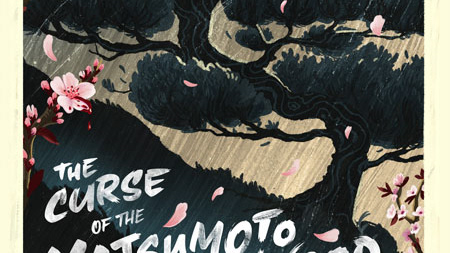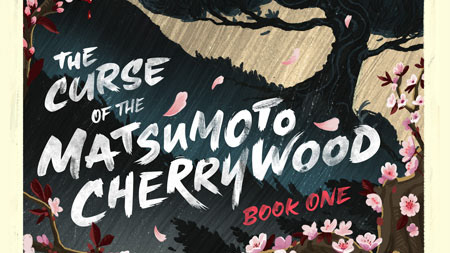ukiyo: 浮世 floating world; e絵: art
ukiyo-e prints were the first examples of colour printing, and the print blocks, hanga版画 were milled from cherrywood. I named the story The Curse of the Matsumoto Cherrywood as ukiyo-e is at its heart. Oddly, Floating World prints are often described as a representation of ‘real’ life, even though the Buddhist term implies the transience of life. But it also refers to the red light district of Edo, current-day Tokyo. It was a version of reality mediated by the explosion of trade and popular culture that flowed from the end of more than a hundred years of brutal civil war and the stabilisation of a central administration. The new era brought new technologies, markets and a wider distribution of wealth in shifting social strata.
These days life is seen through a digital lens. Slo-mo, high-def, 16-bit, megapixel cameras deliver uncountable versions presenting candied snaps of self in feeds. It’s a fiction created by us for us, a mass-culture, a global economy, a social experiment of twenty-year longitude. We edit these pictures before publishing, cropping and colouring our world in the manner we wish to project.
Since early in the twentieth century, phenomenologists considered the relationship of the self to the phenomena of the world. One could discover the self by studying the way one perceived things about. In one sense, visual art is a record of the historical changes of the manner of perception. The vision of the Renaissance, Neo-Classicism, Impressionism, Post-Modernism or in Japan, Kano[1]
Tosa[2]
Rinpa,[3]
could be described as a culture’s selfie, that is, a construction of reality.Using the innovation of oil paint, Renaissance painters glorified the gods and their patrons with lush portraits while much of Europe starved.The discovery of buried relics in Italy and Greece drew the aristocratic 18th century Neo-classical eye to cool marble antiquities, their cousins the Romantics created narratives around the associated mythology, morality and political discourse of those halcyon days while women fought for suffrage.[4]
All these schools placed the privileged viewer at the centre by using Brunelleshi’s perspective experiment of the early 15th century when he drew a grid on a mirror to chart the lines of recedence.[5]
But glass mirrors were not seen in Japan until the Dutch brought them in the late 18th century, by which time systems of depicting symbol and narrative were very well established.[6]
The religious stories of Chinese Buddhism used natural phenomena like trees, rocks, rivers and mountains as symbols of philosophy and devotion. Receiving that influence, the Japanese art movements such as the Tosa, with its strange bird’s-eye-view, literally opened the roof on court intrigue. Kano-school pasted ancient plum blossom trees against gold-leaf, often wide format or horizontal scroll, the Rinpa patterned flowers.
Western perspective drawings and paintings came to Japan from the early 18th century in Dutch traders, but were largely rejected by local artists who preferred, rather than to adhere slavishly to the vanishing point with its individualistic viewing mode, to create schemes of representation with meaningful placement of symbolic objects. Castles float among clouds while peasants work the fields below; rear demons loom over oblivious tea-drinkers; mountain tips loft closer than humans beneath.[1]
The Tokugawa Shoguns ruled from 1603 to 1856 turning an eastern fishing town into a city of one million residents called Edo (Tokyo). Many of them read books, appreciated art and bought clothing from catalogues. Halfway through the 18th century, when the demand for printed books reached 100,000 per-year, when posters washed with colour after printing advertised the latest kabuki theatre or calendars asked readers to guess the short and long months of the year, a more efficient means of bringing colour to the narratives became necessary.
I advanced so far with the first draft of The Curse of the Matsumoto Cherrywood without acknowledging my own attraction to the innovation of colour in ukiyo-e. Victoria Finlay’s book ‘Colour, travels through the paintbox’ shows the far-flung places that the western masters sourced their brilliant colours.[2] The use of colour in Japanese art is no less important to the development of its culture, and when I examined my association with ukiyoe, I realised that the ‘floating world’ that beckoned to me was singing in visual tonality. In my story, colour-print technology is conceived by divine inspiration given to a single artist–but the truth is always more prosaic. A collective approach was necessary in woodcut printing, as publisher, designer, carver and colourist created efficiencies in production. It makes sense therefore that though Suzuki Harunobu is credited with the first colour (calendar) print in 1764, that the technology that made this possible was developed in collaboration over time.Registration of different colour passes on the one sheet was crucial, as was the use of mulberry bark paper, which was strong enough for repeated rubbings. It’s important for magic realism not to lose sight of the real bit. So I researched the use of colour. Not till the turn of the 19th century did imported mineral pigments such as the Prussian blue seen in Hokusai’s prints come to be used.[3]
Before that time, safflower made red, dayflower blue, amur cork or turmeric yellow, ground shells white and lamp soot made black with rice starch to thicken and apply the mix. Some of these, particularly the safflower and dayflower are extremely sensitive to light, and so many of these 18th century prints display colour faded, changed or absent.[4]
I took this cultural fantasy of Edo for the mise-en-scène of the first part of Book One of The Curse of the Matsumoto Cherrywood and relieved it with some of the more gritty truths that are available in many of the excellent English accounts, for example by Timon Screech on foreign influence, or Nishiyama Matsunosuke on Nihonbashi culture, or Yabuta Yutaka’s paper on the women of Edo.[5] Understanding the both the real life and the way Edoites wished to see themselves was important for my story because ukiyo-e was where I commenced the writing. Harunobu’s prints of courtesan’s holding kimono closed against the wind, Hiroshige’s exquisitely composed postcards of famous touring spots, Hokusai’s transcendent representations of nature, these were views not just looking through the roof upon court scandals, or ancient mythologies on gold-leaf screens, but illuminations of all facets of society. Ultimately all we have left, Japanese or foreigner, are the second or third-hand accounts interpreted by writers and these mass-produced snapshots to understand how central was the appreciation of culture in Edo, and how widespread its influence on the identity of all Japan.
Elsewhere in my blogs I detail that the ukiyo-e of the Edo era is not the only historical window into the the story, but in terms of inspiring me to write, the colourful design of slices of life of the Edo period was central in my early research and in developing this story. In many ways, I am only continuing a long tradition of artists of the West who have been inspired in this way, albeit I hope, aware of the candied view that humans often desire of life that displays grittiness beneath.
Footnotes
[1] Katsushika Hokusai, ‘Katsushika Hokusai | Nihonbashi in Edo (Edo Nihonbashi), from the Series Thirty-Six Views of Mount Fuji (Fugaku Sanjūrokkei) | Japan | Edo Period (1615–1868)’, The Metropolitan Museum of Art, 32 1830, https://www.metmuseum.org/art/collection/search/55237.
[2] Victoria Finlay, Colour: Travels through the Paintbox, A Sceptre Paperback (London: Sceptre, 2002).
[3] Katsushika Hokusai, ‘Katsushika Hokusai | The Amida Falls in the Far Reaches of the Kisokaidō Road’, The Metropolitan Museum of Art, ca 1832, https://www.metmuseum.org/art/collection/search/56143.
[4] Paul M. Whitmore and Glen R. Cass, ‘The Ozone Fading of Traditional Japanese Colorants’, Studies in Conservation 33, no. 1 (1988): 29–40, https://doi.org/10.2307/1506238.
[5] Yukio Lippit and Timon Screech, ‘Fantasies and Foreign Contact in the Art History of Japan: Timon Screech in Conversation with Yukio Lippit’, The Art Bulletin 95, no. 2 (2013): 212–18; ‘Chapter 2. Edokko: The Townsperson’, in Edo Culture: Daily Life and Diversions in Urban Japan, 1600-1868, by Matsunosuke Nishiyama and Gerald Groemer (Honolulu, HI: University of Hawaiʻi Press, 1997), 41–52; Yutaka Yabuta, Rediscovering Women in Tokugawa Japan (Harvard University, Edwin O. Reischauer Institute of Japanese Studies, 2000).
Bibliography
‘Chapter 2. Edokko: The Townsperson’. In Edo Culture: Daily Life and Diversions in Urban Japan, 1600-1868, 41–52. Honolulu, HI: University of Hawaiʻi Press, 1997.
Cole, Thomas. The Course of Empire The Arcadian or Pastoral State 1836.Jpg. 1834. https://en.wikipedia.org/w/index.php?title=File:Cole_Thomas_The_Course_of_Empire_The_Arcadian_or_Pastoral_State_1836.jpg&oldid=985166590.
Finlay, Victoria. Colour: Travels through the Paintbox. A Sceptre Paperback. London: Sceptre, 2002.
Hokusai, Katsushika. ‘Katsushika Hokusai | Nihonbashi in Edo (Edo Nihonbashi), from the Series Thirty-Six Views of Mount Fuji (Fugaku Sanjūrokkei) | Japan | Edo Period (1615–1868)’. The Metropolitan Museum of Art, 32 1830. https://www.metmuseum.org/art/collection/search/55237.
———. ‘Katsushika Hokusai | The Amida Falls in the Far Reaches of the Kisokaidō Road’. The Metropolitan Museum of Art, ca 1832. https://www.metmuseum.org/art/collection/search/56143.
Kano, Motonobu. ‘Kano Motonobu 狩野元信 | The Four Accomplishments | Japan | Muromachi Period (1392–1573)’. The Metropolitan Museum of Art. Accessed 15 February 2024. https://www.metmuseum.org/art/collection/search/44673.
Lippit, Yukio, and Timon Screech. ‘Fantasies and Foreign Contact in the Art History of Japan: Timon Screech in Conversation with Yukio Lippit’. The Art Bulletin 95, no. 2 (2013): 212–18.
Ogata, Kōrin. ‘Ogata Kōrin | Irises at Yatsuhashi (Eight Bridges) | Japan | Edo Period (1615–1868)’. The Metropolitan Museum of Art, 1709. https://www.metmuseum.org/art/collection/search/39664.
Sarah. ‘Brunelleschi “Rediscovers” Linear Perspective’. Drawing Academy, 27 December 2014. https://drawingacademy.com/brunelleschi-rediscovers-linear-perspective.
The Metropolitan Museum of Art. ‘Tosa School | Scenes from The Tale of Genji | Japan | Edo Period (1615–1868)’. Accessed 15 February 2024. https://www.metmuseum.org/art/collection/search/670974.
Utamaro, Kitagawa. ‘Woman Looking at Her Face in Mirror’. Syracuse University, 1800. https://onlinecollections.syr.edu/objects/4163/woman-looking-at-her-face-in-mirror.
Whitmore, Paul M., and Glen R. Cass. ‘The Ozone Fading of Traditional Japanese Colorants’. Studies in Conservation 33, no. 1 (1988): 29–40. https://doi.org/10.2307/1506238.
Yabuta, Yutaka. Rediscovering Women in Tokugawa Japan. Harvard University, Edwin O. Reischauer Institute of Japanese Studies, 2000.

